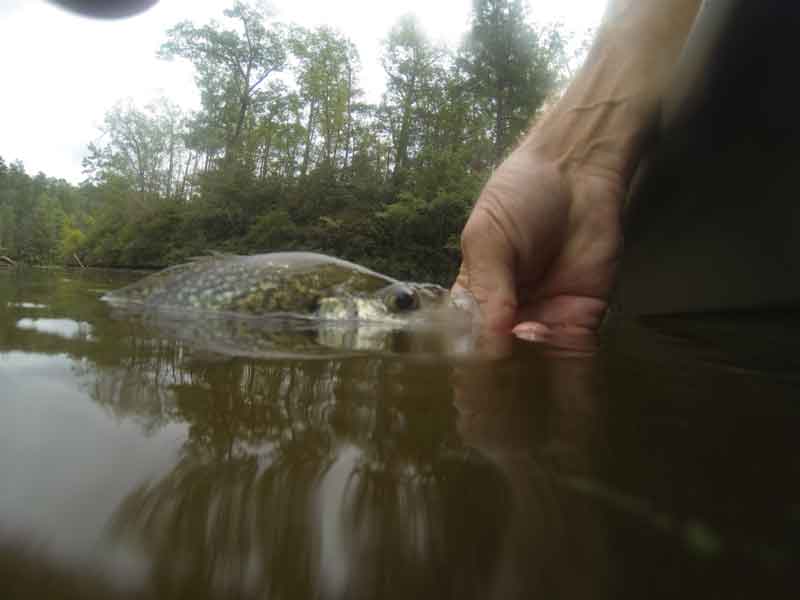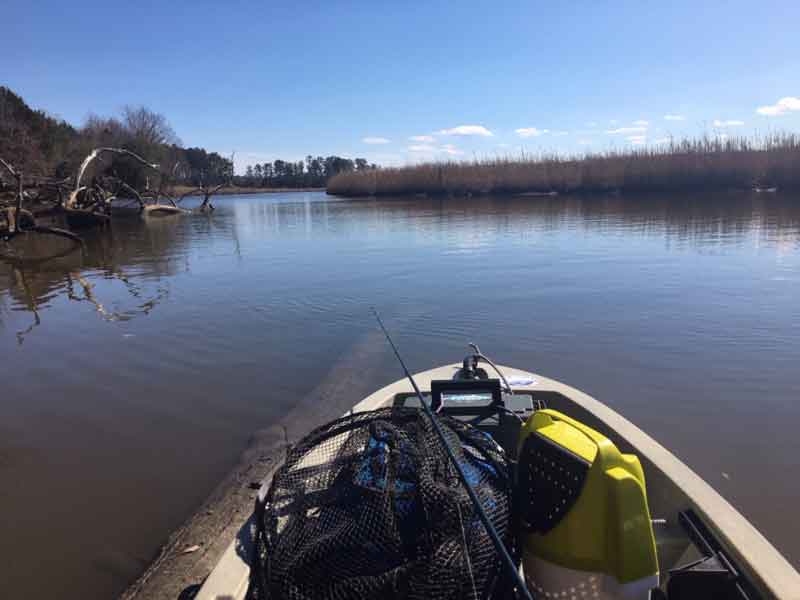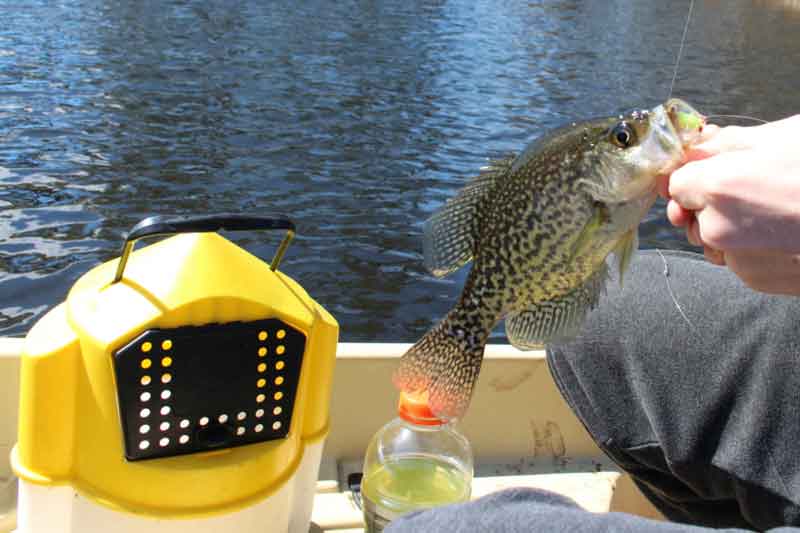Ask an angler living in Chesapeake Country if they’re a saltwater fisherman or a freshwater fisherman, and the answer you’ll commonly get is “yes” because with so many options at our doorstep ranging from fly fishing for wild trout to offshore trolling for pelagics—not to mention the brackish bounty found while Chesapeake Bay fishing—most of us indulge in an all-of-the-above attitude. And at this time of year, when we’re still waiting for many of the saltier opportunities to rev up, plenty of anglers have freshwater action on the mind. As you prepare to fish the fresh, always remember:

- Structure Your Behavior – We all know that structure is a critical element of finding fish, but it takes on a much more substantial meaning in freshwater as opposed to salt. The vast majority of freshwater fish relate to structure far more often than they cruise through or school in open waters. Sure, there are exceptions like pods of stripers or bass that form around schools of shad in reservoirs like Lake Anna, or schools of open-water crappie sometimes found meandering around in the middle of Eastern Shore millponds. But these are the exceptions. As a general rule of thumb, in most scenarios you’ll want to make sure your lures or baits are presented within inches, or at most a few feet, of some form of physical structure. And close proximity often counts—a bass hiding under a log might not move more than a few feet to strike at that spinnerbait, and in freshwater precision casting is often paramount to success.

Finding and working structure is a critical component of freshwater fishing. Photo courtesy of Eric Packard -
Use the Right Tool For the Right Job – The medium-action spinning or casting rig you have spooled up with 20-pound braid for striper jigging may seem to be on the light side out on the Bay, but in most freshwater fisheries it amounts to heavy artillery. Don’t force an inappropriate adaptation, if you want to be successful. We’ve seen folks add a trace of six-pound test to the end of that rockfish rig and then try to cast for crappie, only to discover they can’t fling their tiny tube jig more than 10 feet. That’s definitely not a recipe for success. Instead, make sure you have sets of gear that are appropriate to the fisheries you plan to pursue.
-
Be Prepared to Break Out the Beer – No, not that beer. We’re talking about root-beer colored lures, which no freshwater angler should ever fail to carry in the tacklebox. It’s critical you keep ‘em on hand, because when you encounter tannic-stained waters (and sooner or later just about all freshwater fishermen will) root-beer, copper, and similar colors become killers.
-
Match the Hatch – In freshwater lakes, ponds, and rivers the diversity of available prey is often much more limited than it is in the saltwater environment. As a result, closely matching prey species is often critical. Take those tiny crawfish-imitating crankbaits, for example. These often prove utterly devastating when fished in a rocky river, but will likely produce little in a stillwater pond that doesn’t have a natural crayfish population. Or consider reservoir fishing, where the difference between bull minnow and shiners can be the difference between a getting few bites and having a banner day. Need we even bring up matching your fly selection to the constantly-changing nature of the prey available to wild trout?
-
Wash Your Hands – Maybe it’s because freshwater fish often have a longer time to assess a bait, maybe smells disseminate better in freshwater, or maybe some freshwater species simply have finer-tuned olfactory acuity—for whatever reason, contaminants that affect smell and/or taste definitely seem to be more impactful effect in freshwater environs. Sharpies know to wash their hands before they begin fishing, and some people even carry a bar of unscented soap so they can wash their hands directly in the waters they’re fishing.
-
Use Flurocarbon – Many salty anglers do this as well, particularly when going after species with excellent eyesight. But the effect of fluorocarbon is just as pronounced in many freshwater situations. Obviously, we’re not focusing on things like fishing for catfish in a muddy river. But when it comes to fooling a finicky bass or a leader-shy crappie into biting, having fluorocarbon on the end of your line will definitely boost your catch rate.
-
Acclimate Live Baits – Take a bait out of your sun-warmed 80-degree bucket of water, put it on your hook, and cast it out into a 50-degree lake, and thanks to the shock that follows the abrupt temperature change, it won’t do much wiggling. Specifically, we’re talking about minnow and shiners here, but to some degree other baits like crayfish can be affected as well. Before you use them, acclimate baits to the water you’re fishing in by slowly mixing the lake or pond water into the minnow bucket over a 10 or 15 minute period. That way, when your baits hit the water they’ll be lively and kicking.

Slowly change out the water in your minnow bucket after arriving at a lake, so the minnow get acclimated to the local conditions before you start fishing with them. -
Hush Up! – We all know how important it can be to keep quiet and avoid making fish-spooking sounds and vibrations. But the effect is magnified, sometimes greatly, in the more frequently sheltered freshwater environment. The factor to keep in mind here is the level of “acoustic noise” (background noise created by things like waves). The less background noise there is, the lower its masking effects and thus the more imperative your own stealth becomes. Bonus Tip: shoreline anglers also need to watch their footsteps. The vibrations caused by trotting down a quiet shoreline will alert everything within casting distance of your presence.
-
Be Wary of Noise-Making Lures – This goes hand in hand with the previous tip, because even though some loud noise-making lures can call in fish from afar, they can also scare fish in a very quiet environment. Two classic examples are the Rat-L-Trap and topwater chuggers. Both can be highly effective for drawing strikes on a wind-whipped lake, but try casting them in a silent cove and you’re just as likely to scare the bejesus out of that bass as you are to get a hit.
- Watch Your Shadow – Freshwater fish are very accustomed to—and scared of—birds of prey. As a result, they’re also scared by the sudden appearance of shadows and casting your shadow across a hotspot can totally burn it. Remember that although your shadow may not travel far across the surface, it certainly travels down though the water. This is one of the reasons (also see tips eight and nine above) why repeatedly drifting over deep-water structure like submerged timber stands usually has diminishing returns. Position your boat taking its shadow into account, and you’ll end up catching more fish.
Armed with these 10 freshwater fishing tips, are you guaranteed to enjoy non-stop action the next time you hit the lake? Of course not. But one thing is for sure: commit these to memory and over the long term, your catch rate absolutely, positively will go up.